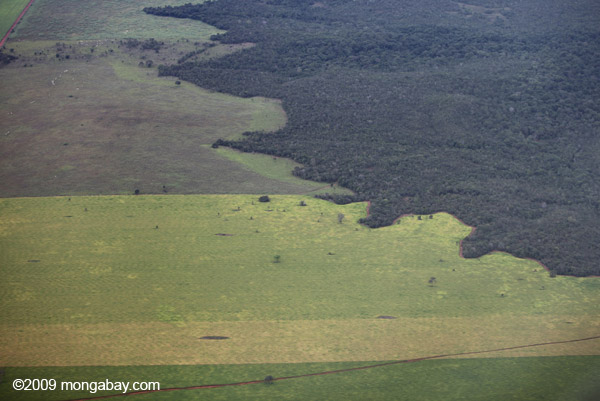
The Amazon rainforest meets cleared area for cattle pasture. A radical meteorology theory argues that loss of forest, both in temperate and tropical regions, will lead to less precipitation over land. Photo by: Rhett A. Butler.
New, radical theories in science often take time to be accepted, especially those that directly challenge longstanding ideas, contemporary policy or cultural norms. The fact that the Earth revolves around the sun, and not vice-versa, took centuries to gain widespread scientific and public acceptance. While Darwin’s theory of evolution was quickly grasped by biologists, portions of the public today, especially in places like the U.S., still disbelieve. Currently, the near total consensus by climatologists that human activities are warming the Earth continues to be challenged by outsiders. Whether or not the biotic pump theory will one day fall into this grouping remains to be seen.
First published in 2007 by two Russian physicists, Victor Gorshkov and Anastassia Makarieva, the still little-known biotic pump theory postulates that forests are the driving force behind precipitation over land masses. Since the biotic pump turns modern meteorology on its head, it has faced stiff resistance from some meteorologists and journals. Meanwhile, it has received little attention in the public or policy-sphere. Yet if Gorshkov and Makarieva’s theory proves correct, it would have massive implications for global policy towards the world’s forests, both tropical and temperate.
“The biotic pump is a mechanism in which natural forests create and control ocean-to-land winds, bringing moisture to all terrestrial life,” Gorshkov and Makarieva told mongabay.com in a recent interview. According to them it is condensation from forests, and not temperature differences, that drives the winds which bring precipitation over land.
 Forest in Big Sur, California. Photo by: Rhett A. Butler. |
“The biotic pump concept gives a consistent physical explanation of how this should be interpreted. Rather than focusing on temperature gradients, which are often a consequence rather than cause of the circulation, one should investigate the conditions when condensation is likely to occur to predict changes in atmospheric circulation,” they say, adding that recent work has used the biotic pump to quantitatively explain tornadoes and hurricanes.
But such a radical theory does not gain acceptance or even acknowledgement easily.
“The biotic pump theory calls on the meteorological community to admit a possibility that an important atmospheric circulation driver has been overlooked. As long as one continues to ignore the role of condensation in driving winds, one will continue to ignore the real role of forests in the water cycle and climate,” Gorshkov and Makarieva say, adding the current underpinnings of meteorology fail to adequately explain drought and flood events around the world. In addition, the biotic pump theory helps shed light on the rise and fall of past civilizations, such as the Nazca and the Maya.
Gorshkov and Makarieva argue that despite skepticism, the biotic pump theory deserves the full consideration of scientists—quickly.
“Given the deforestation threat, there is no time to lose,” they say, further noting that only natural forests, and not monoculture tree plantations, are able to act as biotic pump due because of the ecological changes that occur when forest is converted into plantations.
“The biotic pump theory shows that natural forests are indispensable if we want to have rainfall, and, consequently, agriculture on the land where we live. This scientific message has important economic implications,” Gorshkov and Makarieva say. “First of all, people and governments worldwide should realize that economic growth cannot occur at the expense of cutting forests either in one’s own country or elsewhere. It is undermining the very pillars of our civilization’s existence. When water and food security are at stake, it is not possible for forest industries to focus on growth, just to increase the global production of wrapping and toilet paper. This should be the main topic of environmental campaigns.”
It has long been known that the world’s forests provide refuge to the vast majority of terrestrial species, store massive amounts of carbon, safeguard many of the world’s most important watersheds, and are home to numerous indigenous groups, yet forests continue to fall at staggering rates. If biotic pump theory proves true, it adds a new and vital ecosystem service to the world’s forests: rainmakers.
In a January 2012 interview Victor Gorshkov and Anastassia Makarieva describe the mechanics of the biotic pump theory, the difficulties of gaining notice in the meteorology community, the relation of the biotic pump to climate change, and how deforestation in places like the Amazon and Indonesia threaten precipitation.
A NEW METEOROLOGY: AN INTERVIEW WITH VICTOR GORSHKOV AND ANASTASSIA MAKARIEVA
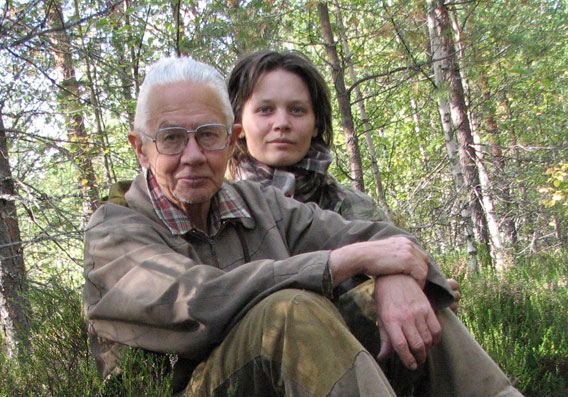
Victor Gorshkov and Anastassia Makarieva.
Mongabay: Will you tell us how the biotic pump works?
Victor Gorshkov and Anastassia Makarieva: The biotic pump is a mechanism in which natural forests create and control ocean-to-land winds, bringing moisture to all terrestrial life. Winds tend to blow from areas of high air pressure to low. But how is a low pressure system created over land? Air pressure depends on the number of gas molecules. When water vapor condenses, it disappears from the gas phase; the number of gas molecules diminishes, and the air pressure falls. Therefore, if we manage to maintain the process of condensation over land, the latter becomes a persistent low pressure zone.
Water vapor in Earth’s atmosphere possesses a remarkable physical property: it is unstable to condensation. This means if an air volume containing a lot of vapor is occasionally displaced upward, the air will cool so significantly that the vapor condenses. Due to this instability, if there is a sufficient amount of water vapor in the warm lower atmosphere condensation will occur.
The green foliage and branches of trees have a much greater cumulative area than that of a tree projection on the ground. Hence, forest evaporation enriches the atmosphere with water vapor more efficiently than evaporation from an open water surface of the same area. Consequently, condensation occurs more readily over forests than over the ocean. Forests, rather than the ocean, become the low pressure zone where the moist winds converge to. Completing the cycle, moisture precipitates over the land and returns to the ocean in the form of river runoff.
Mongabay: Why do you associate the biotic pump with natural forests rather than with trees in general? Could a monoculture tree plantation act as biotic pump?
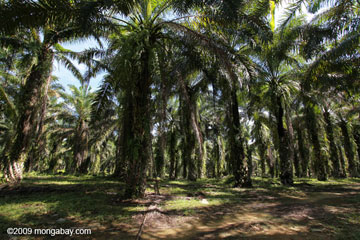 A palm oil plantation on the island of Sumatra in Indonesia. Such plantations may look like ‘forest,’ but Gorshkov and Makarieva argue that the biotic pump doesn’t work over monoculture plantations as well as over natural forest. Photo by: Rhett A. Butler |
Victor Gorshkov and Anastassia Makarieva: As with all life processes, the biotic pump is a highly-organized complex process. In order to sustain condensation that keeps the air pressure low on land—so that moist winds blow to land from the ocean—there must be intense evaporation from the forest canopy. But evaporation diminishes the amount of moisture in soil. Moisture is additionally lost from soil by gravitational runoff. If all the soil moisture is gone, evaporation stops, and so does the atmospheric moisture transport. This means that a non-trivial balance must be maintained: forest evaporation must be exactly such that it never fully depletes the soil moisture but at the same time is intense enough to ensure that the amount of moisture brought from the ocean by winds compensates moisture losses in the soil.
Native species that form natural forest communities have evolved a complex set of genetically encoded biophysical and morphological traits that make the biotic pump possible. These traits took hundred million of years to evolve. For example, the root system of forest trees facilitates both storage and extraction of moisture from soil; biogenic aerosols produced by trees control the intensity of water vapor condensation over the forest; the large height of trees determines the vertical temperature gradient under the canopy, keeping soil evaporation under biotic control; tall trees are also essential for surface friction that does not allow extremely high wind velocities to develop. Thus, natural forests not only create an ocean-to-land moist air flow, but also stabilize this flow at an optimum level and prevent its extreme fluctuations like hurricanes, tornadoes, severe droughts or floods. Species other than plants (bacteria, fungi, animals) are essential for the stability of the forest ecosystem itself.
Monocultures or plantations consisting of a random set of plant species do not possess the required set of correlated traits. To give two extremely simplified examples: if one plants cacti, they will evaporate too little and will be unable to keep the atmosphere persistently moist. If one plants eucalyptus, they will evaporate readily but will be unable to prevent soil from drying. In either case, the biotic pump will not work. Generally, information fluxes processed by the natural biota exceed by twenty orders of magnitude the information processing capacity of modern civilization. It is not possible to create a technological analogue of the biotic pump.
THE SCIENCE BEHIND THE BIOTIC PUMP THEORY
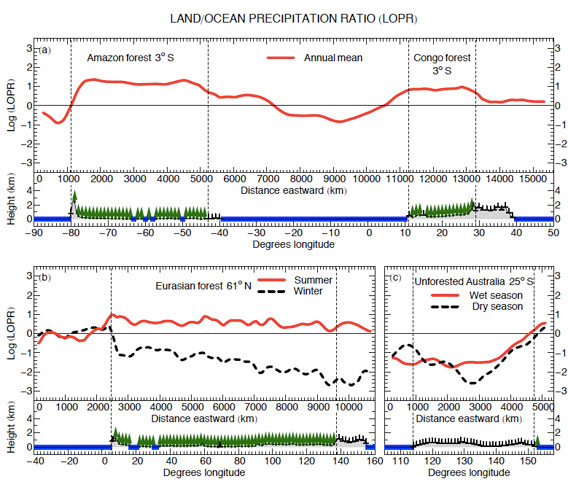
This figure shows the “tug-of-war” between the forest and the ocean for the right to become a predominant condensation zone. In Fig. a: on average the Amazon and Congo forests win this war: annual precipitation over forests is two to three times larger than the precipitation over the Atlantic Ocean at the same latitude. Note the logarithmic scale on the vertical axis: “1” means that the land/ocean precipitation ratio is equal to e = 2.718, “2” means it is equal to e2 ≈ 7.4; 0 means that this ratio is unity (equal precipitation on land and the ocean); “-1” means this ratio is 1/e ≈ 0.4; and so on. In Fig. b: the Eurasian biotic pump. In winter the forest sleeps, so the ocean wins, and all moisture remains over the ocean and precipitates there. In summer, when trees are active, moisture is taken from the ocean and distributed regularly over seven thousand kilometers. The forest wins! (compare the red and black lines) As a result, precipitation over the ocean in summer is lower than it is in winter, despite the temperature in summer is higher. Finally, in panel (c): an unforested Australia. One can often hear that Australia is so dry because it is situated in the descending branch of the Hadley cell. But this figure shows that such an interpretation does not hold. Both in wet and dry seasons precipitation over Australia is four to six times lower than over the ocean. There is no biotic pump there. Being unforested, oceanic moisture cannot penetrate to the Australian continent irrespective of how much moisture there is over the ocean; during the wet season it precipitates in the coastal zones causing floods. Gradually restoring natural forests in Australia from coast to interior will recover the hydrological cycle on the continent. Click to enlarge.
Mongabay: Have there been any significant changes to your biotic pump theory over the last couple years?
Victor Gorshkov and Anastassia Makarieva: The physical basis of the biotic pump consists in the statement that winds are driven mostly by condensation-induced pressure gradients rather than by temperature differences (such as warm air rises) as conventionally considered. As we judged from the first reactions to our work, this is the most difficult statement for the meteorological community to accept. Recently we concentrated our efforts on demonstrating the quantitative validity of the proposed mechanism of condensation-induced atmospheric dynamics. We have shown that it quantitatively explains hurricanes and tornadoes, having obtained from theory radial profiles of pressure and velocity that agree well with observations. On the other hand, we criticized some of the existing explanations of the same phenomena arguing that these contain physical errors. A full list of our publications concerning the biotic pump can be found here.
Mongabay: Have you seen wider acceptance in the scientific community for your theory?
 Redwood forest of Russian Gulch State Park in California. Photo by: Rhett A. Butler |
Victor Gorshkov and Anastassia Makarieva: Generally, judging from the increasing number of citations of our first biotic pump papers, our work is gradually gaining more attention. The biotic pump theory calls on the meteorological community to admit a possibility that an important atmospheric circulation driver has been overlooked. As long as one continues to ignore the role of condensation in driving winds, one will continue to ignore the real role of forests in the water cycle and climate. Given the deforestation threat, there is no time to lose. So we are undertaking all possible efforts to stimulate a constructive discussion of condensation dynamics by members of the meteorological community.
Still, the progress appears to be slow. In 2010 we submitted an overview of the theory to the journal ACPD, Atmospheric Chemistry and Physics Discussions that allows for an open discussion of submitted papers: Makarieva A.M., Gorshkov V.G., Sheil D., Nobre A.D., Li B.-L. (2010) Where do winds
come from? A new theory on how water vapor condensation influences atmospheric
pressure and dynamics. Atmospheric Chemistry and Physics Discussions, 10, 24015-
24052.
For six months the editors could not find reviewers willing to publicly evaluate our work. After we informed the wider scientific community of our situation, a leading NOAA hydrologist circulated our work among many of his colleagues-meteorologists. Only one of them considered the possibility of becoming a referee, and he strongly objected to our work. As we have always welcomed any criticism to be put forward openly regarding our work, we suggested that the editor invite the referee even though we knew in advance that he had a negative view of our work. After the negative review was posted, we replied to all the arguments. Since then the paper was suspended, it has now been in open review for over fifteen months and it’s been twenty months since our submission. As any scientist will tell you, such extraordinary impediments and delays would discourage any researcher; they are disrupting the normal scientific process. But we remain hopeful that our efforts are not in vain.
Mongabay: Can you give an example of why the current understanding of condensation and precipitation is wrong?
Victor Gorshkov and Anastassia Makarieva: Our work was discussed rather widely on the web, sometimes with direct or indirect participation of leading meteorologists. These discussions revealed that the physics of condensation has not been given sufficient attention by the meteorological community, the result being that even some very basic issues remained unresolved and unclear to many. For example, a question that caused a lot of confusion was: if condensation occurs in the atmosphere and some vapor turns to liquid, will air pressure at the surface be affected near instantaneously or only after the raindrops have fallen to the ground? The latter is a common view caused by a fundamental misunderstanding of the concept of hydrostatic equilibrium.
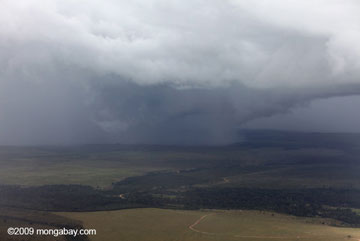 Rainstorm over the Amazon. Photo by: Rhett A. Butler. |
In hydrostatic equilibrium, air pressure at any height is equal to the weight of air in the atmospheric column above that height. Many meteorologists think that hydrostatic air pressure at the surface is equal to the weight of both air and all the liquid and solid bodies including the raindrops that are in the upper atmosphere. Had this been true, condensation in hydrostatic equilibrium could have never changed the surface pressure prior to precipitation fallout, because condensation of gas (vapor) into liquid does not change the total amount of matter. However, ideal gas pressure depends on the number of particles not their mass. The number of liquid drops is many orders of magnitude smaller than the number of gas molecules that have condensed into those drops. Therefore, condensation immediately lowers air pressure and disturbs the hydrostatic equilibrium. Recently a paper devoted to this question was published in a leading meteorological journal where, with use of numerical modeling, this conclusion was articulated. That a paper with such a basic conclusion has appeared only now—in the second decade of the Twenty First Century—demonstrates that the efforts to study the dynamic effects of condensation by the meteorological community are in their incipient stage.
In the meantime, practically all climate and weather phenomena where condensation and precipitation are involved are challenging modern meteorology. For example, the existing global circulation models do not adequately describe the water cycle in the Amazon, with the modeled moisture convergence being half the actual amounts estimated from the observed runoff values. It is widely recognized that despite the ever-improving observation facilities and the available computer power, there is no progress in predicting the intensity of tropical cyclones.
When analyzing how precipitation changes with time (e.g., in the Amazon or Congo regions) it is common to explore correlations with oceanic temperature anomalies. The conventional logic is that as the ocean becomes warmer, the warm air rises over the ocean and moisture precipitates there rather than over land, hence a drought occurs. However, such logic does not take into account that as the land becomes drier, it also warms significantly. It is unexplainable within the conventional paradigm why the warm air does not rise over the hot and dry land. All heat waves and droughts, like the one in European Russia in 2010 or the one in Texas in 2011, are associated with persistent descending air motion.
Neither are flooding events explained by the conventional paradigm. For example, of the two extreme floods that hit Thailand in 2011, the first one occurred early in the year during the dry season. Then the land is cooler, the ocean is warmer and winds blow from land to the ocean, so that the continent remains dry. In early 2011 the region was struck by an unusual cold wave, which caused this temperature gradient to become even more pronounced. According to the conventional paradigm, this should only strengthen dry conditions. In reality, however, a major flooding happened.
Evidence of this type, which is controversial with respect to the conventional paradigm, is mounting and the biotic pump concept gives a consistent physical explanation of how this should be interpreted. Rather than focusing on temperature gradients, which are often a consequence rather than cause of the circulation, one should investigate the conditions when condensation is likely to occur to predict changes in atmospheric circulation.
REGIONAL EXAMPLES OF THE BIOTIC PUMP

The Maya city of Tulum. Research is adding up that deforestation may have been a large factor in the decline of the Mayan civilization. Photo by: Rhett A. Butler.
Mongabay: Recent evidence has linked the decline and fall of the Maya civilization to deforestation leading to less precipitation. How could the biotic pump theory connect to this?
Victor Gorshkov and Anastassia Makarieva: This data, as well as the data on the Nazca civilization in Peru, are in agreement with the biotic pump concept. It is noteworthy that the Yucatan peninsula is a relatively small region with maximum distance from coast never exceeding a thousand kilometers. This means that even so close to the ocean, massive deforestation can cause a significant precipitation decline.
The proposed explanation (see article: Evidence mounts that Maya did themselves in through deforestation) based on a slight change in albedo after deforestation and a corresponding decrease in solar energy available for convection does not make sense to us (although as we understand this work has not yet been published so we could not read it in detail). The power of atmospheric circulation does not exceed around 1 percent of solar power. It is not limited by solar radiation, but by the flux of potential energy available for conversion to the kinetic energy. The conventional paradigm associates this potential energy with temperature-related buoyancy. That is, to put things simply, if you do not have a temperature difference, you do not have a circulation, all other things (including solar energy) being the same. We propose a different source of potential energy associated with water vapor removal from the gas phase: after the Mayan forests were destroyed, evaporation and condensation ceased to occur over the Yucatan peninsula (irrespective of how its albedo changed). The result was that the low pressure zone was no longer there and moist air ceased to come to the Maya from the ocean. Generally, the biotic pump theory calls us to re-analyze the historical evidence associated with land cover change and the changes in the precipitation regime.
Mongabay: How do you see deforestation in the Amazon as impacting regional precipitation?
Victor Gorshkov and Anastassia Makarieva: According to recent analyses, during 1973-2003 precipitation in the Amazon River basin was declining at a rate of 0.3 percent annually, which means a trend of about 10 percent for the entire period. This does not include the most recent devastating droughts of 2005 and 2010. In the meantime, deforestation in the basin has amounted to about 30 percent during the same period. Deforestation mostly disturbed southern and south-eastern parts of the basin, where the precipitation/evaporation is less than in the basin core. Assuming that the total biotic pump intensity is a function of the integral of local precipitation over the total forest-covered area, one can conclude that the decrease in precipitation intensity is of the same order of magnitude as the degree of biotic pump deterioration. As deforestation marches to the interior of the basin and affects the ever more productive forests with the most precipitation, the disruption of the water cycle in the basin will increase disproportionately.
Mongabay: How do you think widespread deforestation will effect the hydrological cycle of places like the Indonesian islands? Given their smaller size, do they need the biotic pump?
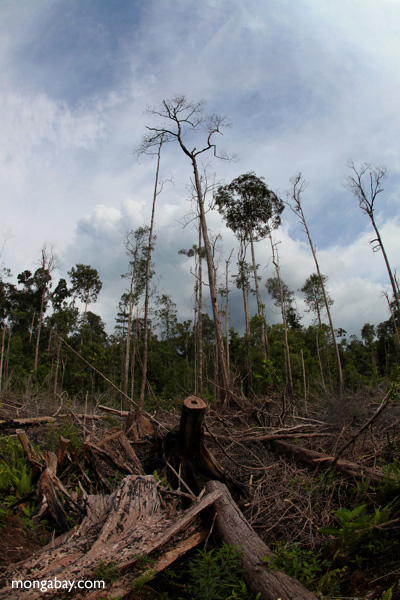 Devastated rainforest landscape in Borneo. Indonesia has one of the highest rates of deforestation worldwide. Photo by: Rhett A. Butler. |
Victor Gorshkov and Anastassia Makarieva: The total area occupied by the Indonesian archipelago, including space between the islands, is quite significant. Open water space between the forest-covered islands can only slightly weaken the biotic pump of the Indonesian forests that likely determine the precipitation regime in the adjacent oceanic regions. Indeed, there is a relatively stable low pressure zone over Indonesia that causes the so-called Walker circulation: surface air moves from the high pressure region of the eastern Pacific ocean towards the low pressure zone over Indonesia. When this low pressure zone diminishes or erodes, the Walker circulation weakens and an El Niño results. When the Walker circulation is strong, we have a La Niña. These phenomena are well-known for their long-range impacts on the climate of the Americas.
The biotic pump theory helps us understand why there is a low pressure system in Indonesia (because of intense condensation associated with forest functioning). Thus deforestation in the region should lead to a weakening of the Walker circulation. While this pattern needs to be further explored, it is worth mentioning that while the period from 1950 to 1975 was largely dominated by La Niña’s (strong Walker circulation), starting from the late 70s the frequency of La Niñas dropped. This is in agreement with the idea that Indonesian deforestation over the last 30 years could have modified the large-scale airflow.
Mongabay: Does the biotic pump theory apply to boreal forests, such as those in Russia, as well?
Victor Gorshkov and Anastassia Makarieva: Biotic pump of the boreal forest zone is fully responsible for atmospheric moisture transport from the (Atlantic) ocean over several thousand kilometers. Recent deforestation in European Russia is apparently disrupting this mechanism causing abnormal warming and droughts.
Mongabay: Does biotic pump theory modify our current understanding of global climate change?
Victor Gorshkov and Anastassia Makarieva: The widespread view is that global climate change is largely due to anthropogenic pollution of the global environment. The main anthropogenic pollutant is carbon dioxide, which is emitted by burning fossil fuels. CO2 is the second most important greenhouse substance in the atmosphere of Earth, therefore its accumulation in the atmosphere is believed to be the main cause of the observed warming and other climatic changes. The main proposed strategy to combat climate change is by reducing carbon emissions.
 Temperate rainforest of Alaska. According to the biotic pump theory, both temperate and tropical forests play a similar role in precipitation patterns. Photo by: Rhett A. Butler. |
However, the greenhouse effect on Earth is mostly determined by water vapor and clouds, i.e., by atmospheric moisture, which is the main greenhouse substance. The absorption interval of CO2 molecules covers less than 20 percent of the spectrum of thermal radiation of the Earth’s surface, while atmospheric moisture absorbs thermal radiation rather uniformly over the entire spectrum. Therefore, the impact of increasing CO2 concentrations on the greenhouse effect can be completely compensated by a relatively minor change in the hydrological cycle over land. Such climate stabilization can be performed by natural forests that control the hydrological cycle on land and the adjacent ocean, provided they are allowed to occupy a significant area. Conversely, destruction of forests leads to disruption of the hydrological cycle, which expectedly causes significant fluctuations of the magnitude of the global greenhouse effect, up to complete loss of climate stability and transition of Earth’s climate to a state incompatible with life.
Most modern climate researchers have grown up on computer models of climate and are used to believing in the model output. As illustrated by the discussion of our work, it is rarely appreciated that by artificially setting the needed numerical parameters it is possible to simulate a very broad range of climate scenarios, including those that will agree with observations of the past. The existence of simulations that mimic the past and present reality does not mean that the physics included in the models is correct or that the model can generate a trustworthy prediction.
What is more, modern climate modeling has been traditionally implemented by people with a technological background and little knowledge of ecosystem functioning. Such knowledge is generally poor, too. Thus, the ecological systems are “fed” into the models as a set of geophysical parameters, e.g., albedo, evaporation rate, surface roughness, amount of stored carbon etc. While the numeric values of these parameters are borrowed from reality, they do not represent the ecosystem functioning in very much the same manner as a colored high-resolution digital photo of a dead corpse does not represent a live human being. Without studying the principles of highly-organized functioning of ecological communities, including their genetically encoded ability to respond to environmental perturbations in a non-random compensatory way, the perspectives drawn from global circulation models with respect to the climatic effects of land cover change (e.g., statements like cutting all boreal forests will ease global warming) will continue to lack any resemblance to reality.
Quantitative analysis of ecological and biological variables is a very complicated task due to the complexity of living objects. Consider a flying canon and a flying bird that are both under gravity. A quantitative description of the former is straightforward, while to predict where and how the bird will fly from initial conditions is not feasible. This complexity of living systems and the number of surprises it implies for global environmental research has only recently begun to be gradually appreciated across a number of disciplines, from organismal energetics to soil biochemistry and climatology.
The biotic pump concept (and more generally the theory of the biotic regulation of the environment of which the former is a part) for the first time quantifies the stabilizing environmental function of natural ecosystems with respect to the hydrological cycle and pinpoints the physical mechanism that is responsible for this function. We must elevate the status of ecosystem conservation from a side issue in global environmental talks and treaties (that are exclusively focused on carbon) to an urgent high priority issue. We must also implement targeted research programs to study the stabilizing impact of natural ecosystems, to stimulate public discussion, and to raise people’s awareness of the real value of forests.
THE BIOTIC PUMP AND POLICY
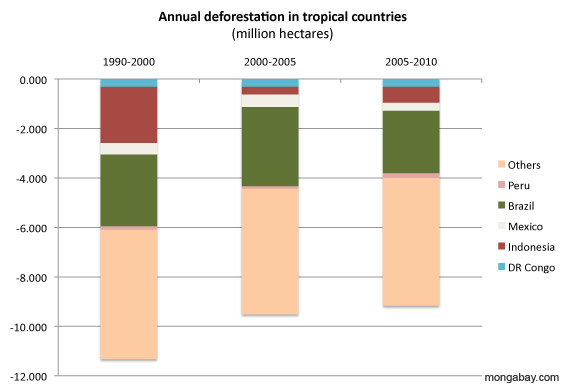
Mongabay: What policy changes does the biotic theory suggest for governments worldwide?
Victor Gorshkov and Anastassia Makarieva: 1. The biotic pump theory shows that natural forests are indispensable if we want to have rainfall, and, consequently, agriculture on the land where we live. This scientific message has important economic implications. First of all, people and governments worldwide should realize that economic growth cannot occur at the expense of cutting forests either in one’s own country or elsewhere. It is undermining the very pillars of our civilization’s existence. When water and food security are at stake, it is not possible for forest industries to focus on growth, just to increase the global production of wrapping and toilet paper. This should be the main topic of environmental campaigns.
There are important branches of human activities where economic growth is not possible: that is, for example, fisheries. Consumption of natural fish products is limited by the rate of their recovery in nature, which is achieved by the mechanism of international quotas. Lack of such regulations could result in transient economic growth, but would ultimately lead to collapse of the entire industry when the fish base is depleted. For a different reason, economic growth is equally not possible based on criminal activities like selling drugs or human organs. Were such activities encouraged, as are other economic activities, this could lead to transient “economic growth” but then to the physical collapse of the population. Where this is understood, people are taking measures against such activities.
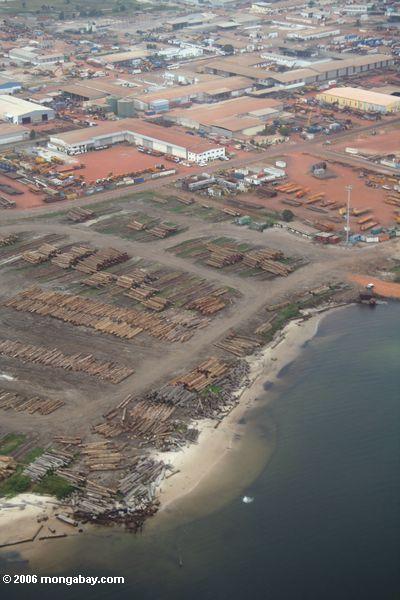 Raw timber lines a port in Gabon. Photo by: Rhett A. Butler. |
The case with the forestry industry is less akin to fishery but more akin to drug and human organ selling. Humanity needs a large territory of natural, intact, undisturbed forests to run the hydrological cycle on land. This strict environmental criterion is incompatible with the criterion of “sustainability” applied in modern forestry, when trees are in the best case cut at the rate at which they regrow and when the majority of trees are cut when they are 50 years of age. Conceptually, this could be compared to growing human beings for organs and killing them when they are, say, fifteen years of age. Such an “economic activity” could be “sustainable” and “profitable” for some, but one cannot expect civilization based on such “economics” to be stable and give birth to Shakespeares, Mozarts, Einsteins etc. Human beings grown for organs cannot live a normal human life, they cannot work creatively or develop. Likewise, trees grown for timber cannot perform their environmental function and stabilize the climate: only a natural ecosystem with a full suite of all the necessary biological species can do this.
In other words, society must urgently take the course of gradually shrinking the forestry industry. Destruction of natural forest ecosystems is a crime against humanity and will be increasingly perceived as such as new knowledge accumulates, environmental literacy increases, and ethical standards change accordingly. Such radical changes have happened in human history: slavery, once perceived as economically prudent and otherwise “normal,” was abolished.
We must emphasize that the responsibility for the current situation, where natural forests are being destroyed, rests on all the people of Earth rather than with the forestry industry alone. We are all consumers of timber products. Because many livelihoods depend directly on forest exploitation today, large-scale programs are needed to gradually change the professional occupation of these people, to slow down the forestry industry and ultimately radically minimize their economic scope. In the meantime, government grants should support research aimed at finding new ways of wrapping things without paper or any other tree-derived product.
2. Governments should remember that natural forest recovery takes many decades and even hundreds of years, before the biotic pump acquires its full power. It is much easier to protect forests than to re-grow them. For example, tree planting in China has nothing to do with forest restoration; it is doomed to fail. To completely restore a degraded ecological communities is as difficult as cloning a mammoth in an elephant egg cell. Ecosystem medicine and health care have not yet developed as a science. In the meantime, we should urgently conserve all that we have now.
3. Efforts should be coordinated to protect both boreal and tropical forests. In countries with strong democracy society is more efficient at achieving nature conservation goals. It becomes possible for society to mitigate the negative environmental impact of even large-scale development projects aimed at resource extraction from yet widening areas. For example, in Canada the implementation of Plan Nord aimed at a massive intensification of resource extraction in Quebec was forced by people to include conservation of 50 percent of the affected territory, including a vast area with boreal forests, in an undisturbed state. This positive experience should be studied and shared among nations.
4. In an overpopulated world forests and the environment cannot be saved. Family planning is the main strategic tool to conserve forests and restore environmental sustainability.
Related articles
Revolutionary new theory overturns modern meteorology with claim that forests move rain

(04/01/2009) Two Russian scientists, Victor Gorshkov and Anastassia Makarieva of the St. Petersburg Nuclear Physics, have published a revolutionary theory that turns modern meteorology on its head, positing that forests—and their capacity for condensation—are actually the main driver of winds rather than temperature. While this model has widespread implications for numerous sciences, none of them are larger than the importance of conserving forests, which are shown to be crucial to ‘pumping’ precipitation from one place to another. The theory explains, among other mysteries, why deforestation around coastal regions tends to lead to drying in the interior.
Bad feedback loop: climate change diminishing Canadian forest’s carbon sink
(01/30/2012) Climate change, in the form of rising temperatures and less precipitation, is shrinking the carbon sink of western Canada’s forest, according to a new study released today in the Proceedings of the National Academy of Sciences (PNAS). Tree mortality and a general loss of biomass has cut the carbon storage capacity of Canada’s boreal forests by around 7.28 million tons of carbon annually, equal to nearly 4 percent of Canada’s total yearly carbon emissions.
Droughts could push parts of Africa back into famine
(12/19/2011) Drought and erratic rains could lead to further food scarcities in Africa warns the United Nations World Food Program (WFP). The WFP singles out South Sudan, the world’s newest nation, and Niger as nations of particular concern. Earlier this year famine killed scores of people, including an estimated 30,000 children, in Somalia.
Is the Russian Forest Code a warning for Brazil?

(12/19/2011) Brazil, which last week moved to reform its Forest Code, may find lessons in Russia’s revision of its forest law in 2007, say a pair of Russian scientists. The Brazilian Senate last week passed a bill that would relax some of forest provisions imposed on landowners. Environmentalists blasted the move, arguing that the new Forest Code — provided it is not vetoed by Brazilian President Dilma Rousseff next year — could undermine the country’s progress in reducing deforestation.
Evidence mounts that Maya did themselves in through deforestation

(12/08/2011) Researchers have garnered further evidence for a smoking gun behind the fall of the great Maya civilization: deforestation. At the American Geophysical Union (AGU) conference, climatologist Ben Cook presented recent research showing how the destruction of rainforests by the Mayan ultimately led to declines in precipitation and possibly civilization-rocking droughts. While the idea that the Maya may have committed ecological-suicide through deforestation has been widely discussed, including in Jared Diamond’s popular book Collapse, Cook’s findings add greater weight to the theory.
Converting rainforest to cropland in Africa reduces rainfall
(09/19/2011) Converting West African rainforests into cropland reduces rainforest in adjacent forest areas, reports research published in Geophysical Research Letters.
Chart: US suffers record drought
(08/01/2011) An exceptional drought is still scorching major parts of Texas, New Mexico, Oklahoma, and Louisiana. A new report from the National Drought Mitigation Center finds that over July, nearly 12 percent of the US saw exceptional drought conditions, the highest record since monitoring began a dozen years. Exceptional drought is the worst possible on a 5-scale drought scale.
An undamaged Amazon produces its own clouds and rain
(09/21/2010) Researchers recently traveled to the remote Brazilian Amazon to investigate how clouds are formed and rain falls in an atmosphere unburdened by human-caused pollution. Studying the atmospheric aerosol particles, which impact cloud formation and particles, above a pristine forests, researchers discovered that when left alone the Amazon acts as its own ‘bioreactor’: clouds and precipitation are produced by the abundance of plant materials.
World failing on every environmental issue: an op-ed for Earth Day

(04/22/2010) The biodiversity crisis, the climate crisis, the deforestation crisis: we are living in an age when environmental issues have moved from regional problems to global ones. A generation or two before ours and one might speak of saving the beauty of Northern California; conserving a single species—say the white rhino—from extinction; or preserving an ecological region like the Amazon. That was a different age. Today we speak of preserving world biodiversity, of saving the ‘lungs of the planet’, of mitigating global climate change. No longer are humans over-reaching in just one region, but we are overreaching the whole planet, stretching ecological systems to a breaking point. While we are aware of the issues that threaten the well-being of life on this planet, including our own, how are we progressing on solutions?
Drought crippling southwest China, millions without drinking water
(03/22/2010) Over 50 million people are affected by a severe drought in southwest China, according to Xinhua, the nation’s state media. The lack of rain and unseasonably high temperatures has also left 16 million people without easy access to drinking water.
Healthy coral reefs produce clouds and precipitation

(03/03/2010) Twenty years of research has led Dr. Graham Jones of Australia’s Southern Cross University to discover a startling connection between coral reefs and coastal precipitation. According to Jones, a substance produced by thriving coral reefs seed clouds leading to precipitation in a long-standing natural process that is coming under threat due to climate change.
Decline in fog threatens California’s iconic redwood ecosystems
(02/15/2010) A surprising new study finds that during the past century the frequency of fog along California’s coast has declined by approximately three hours a day. Published in the Proceedings of the National Academy of Sciences the researchers are concerned that this decrease in fog threatens California’s giant redwoods and the unique ecosystem they inhabit.
Air pollution in China reduces rainfall
(08/31/2009) Air pollution in eastern China over the past half century has reduced rainfall and exacerbated the risk of drought and crop failures, reports a study published in the Journal of Geophysical Research.
Massive deforestation in the past decreased rainfall in Asia

(06/25/2009) Between 1700 and 1850 forest cover in India and China plummeted, falling from 40-50 percent of land area to 5-10 percent. Forests were cut for agricultural use across Southeast Asia to feed a growing population, but the changes from forests to crops had unforeseen consequences. A new study published in the Proceedings of the National Academy of Sciences links this deforestation across Southeast Asia with changes in the Asian Monsoon, including significantly decreased rainfall.